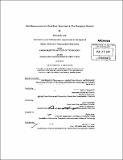| dc.contributor.advisor | Peter A. Traykovski and John Trowbridge. | en_US |
| dc.contributor.author | Link, Shmuel G | en_US |
| dc.contributor.other | Woods Hole Oceanographic Institution. | en_US |
| dc.coverage.spatial | n-mx--- | en_US |
| dc.date.accessioned | 2011-12-09T21:35:24Z | |
| dc.date.available | 2011-12-09T21:35:24Z | |
| dc.date.copyright | 2010 | en_US |
| dc.date.issued | 2011 | en_US |
| dc.identifier.uri | http://hdl.handle.net/1721.1/67625 | |
| dc.description | Thesis (S.M.)--Joint Program in Oceanography/Applied Ocean Science and Engineering (Massachusetts Institute of Technology, Dept. of Mechanical Engineering; and the Woods Hole Oceanographic Institution), June 2011. | en_US |
| dc.description | Cataloged from PDF version of thesis. | en_US |
| dc.description | Includes bibliographical references (p. 55-56). | en_US |
| dc.description.abstract | Throughout this thesis we will discuss the theoretical background and empirical observation of a swell band shore normal flux divergence reversal. Specifically, we will demonstrate the existence and persistence of the energy flux divergence reversal in the nearshore region of Atchafalaya Bay, Gulf of Mexico, across storms during the March through April 2010 deployment. We will show that the swell band offshore component of energy flux is rather insignificant during the periods of interest, and as such we will neglect it during the ensuing analysis. The data presented will verify that the greatest flux divergence reversal is seen with winds from the East to Southeast, which is consistent with theories which suggest shoreward energy flux as well as estuarine sediment transport and resuspension prior to passage of a cold front. Employing the results of theoretical calculations and numerical modeling we will confirm that a plausible explanation for this phenomena can be found in situations where temporally varying wind input may locally balance or overpower bottom induced dissipation, which may also contravene the hypothesis that dissipation need increase shoreward due to nonlinear wave-wave interactions and maturation of the spectrum. Lastly, we will verify that the data presented is consistent with other measures collected during the same deployment in the Atchafalaya Bay during March - April 2010. | en_US |
| dc.description.statementofresponsibility | by Shmuel G. Link. | en_US |
| dc.format.extent | 56 p. | en_US |
| dc.language.iso | eng | en_US |
| dc.publisher | Massachusetts Institute of Technology | en_US |
| dc.rights | M.I.T. theses are protected by
copyright. They may be viewed from this source for any purpose, but
reproduction or distribution in any format is prohibited without written
permission. See provided URL for inquiries about permission. | en_US |
| dc.rights.uri | http://dspace.mit.edu/handle/1721.1/7582 | en_US |
| dc.subject | Joint Program in Oceanography/Applied Ocean Science and Engineering. | en_US |
| dc.subject | Mechanical Engineering. | en_US |
| dc.subject | Woods Hole Oceanographic Institution. | en_US |
| dc.subject.lcsh | Ocean-atmosphere interaction | en_US |
| dc.subject.lcsh | Ocean currents Mathematical models | en_US |
| dc.title | Field measurements of a swell band, shore normal, flux divergence reversal | en_US |
| dc.type | Thesis | en_US |
| dc.description.degree | S.M. | en_US |
| dc.contributor.department | Joint Program in Oceanography/Applied Ocean Science and Engineering | en_US |
| dc.contributor.department | Woods Hole Oceanographic Institution | en_US |
| dc.contributor.department | Massachusetts Institute of Technology. Department of Mechanical Engineering | |
| dc.identifier.oclc | 765966309 | en_US |

